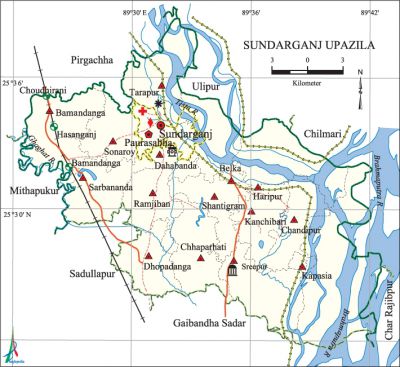Sundarganj Upazila
Sundarganj Upazila (gaibandha district) area 426.52 sq km, located in between 25°24' and 25°39' north latitudes and in between 89°24' and 89°43' east longitudes. It is bounded by pirgachha, ulipur and chilmari upazilas on the north, gaibandha sadar and sadullapur upazilas on the south, Chilmari and char rajibpur upazilas on the east, Pirgachha, mithapukur and Sadullapur upazilas on the west.
Population Total 398588; male 202270, female 196318; Muslim 363607, Hindu 34416, Buddhist 65, Christian 79 and others 421.
Water bodies Main rivers: tista, brahmaputra, ghaghat.
Administration Sundarganj Thana was formed in 1875 and it was turned into an upazila in 1984.
| Upazila | ||||||||
| Municipality | Union | Mouza | Village | Population | Density (per sq km) | Literacy rate (%) | ||
| Urban | Rural | Urban | Rural | |||||
|
1 |
15 |
110 |
183 |
32742 |
365846 |
935 |
39.7 |
30.4 |
| Upazila Town | ||||||||
|
Area (sq km) |
Mouza |
Population |
Density (per sq km) |
Literacy rate (%) | ||||
|
25.96 |
8 |
32742 |
1261 |
39.71 | ||||
| Union | ||||
| Name of union and GO code | Area (acre) | Population | Literacy rate (%) | |
| Male | Female | |||
|
Kanchibari 50 |
5121 |
16412 |
15855 |
32.76 |
|
Kapasia 56 |
14792 |
4812 |
4418 |
21.49 |
|
Chandipur 18 |
5338 |
14110 |
13865 |
30.97 |
|
Chhaparhati 25 |
6593 |
16457 |
15827 |
27.50 |
|
Tarapur 94 |
7442 |
13256 |
13021 |
33.86 |
|
Dahabanda 31 |
5321 |
17356 |
16314 |
39.62 |
|
Dhopadanga 37 |
8182 |
12521 |
11692 |
34.66 |
|
Bamandanga 06 |
8645 |
20300 |
19475 |
35.71 |
|
Belka 12 |
5941 |
8918 |
8621 |
24.27 |
|
Ramjiban 63 |
5508 |
13005 |
12817 |
25.61 |
|
Shantiram 69 |
5074 |
13612 |
13550 |
33.20 |
|
Sreepur 88 |
7442 |
17333 |
17292 |
27.15 |
|
Sarbananda 75 |
6258 |
14975 |
15195 |
28.71 |
|
Sonaroy 82 |
4801 |
10918 |
10756 |
34.86 |
|
Haripur 44 |
8936 |
8285 |
7620 |
21.59 |
Source Bangladesh Population Census 2001, Bangladesh Bureau of Statistics.

Archaeological heritage and relics Remnants of Bamandanga Zamindar Bari, Bhalua Bari Jami Mosque at Dharmapur,' Bamandanga Shiva Mandir, Kurar Math at Ramjiban.
History of the War of Liberation In 1971 the Pak army conducted mass killing, torture, rape and plundering in the upazila. The Pak army tortured to death about 18 innocent persons at different places of the upazila. On the night of Sab-e-Barat in 1971 an encounter was held between the freedom fighters and the Pak army at Mather Hat. In the day following the freedom fighters dismantled the Mather Hat Bridge thereby dislocating the area from the Zila sadar.
Marks of the War of Liberation Mass grave 1; mass killing site 1; Shaheed Minar 1.
Religious institutions Mosque 490, temple 69, sacred place 1. Noted religious institutions: Dhakuabari Jami Mosque at Dharmapur.
Literacy rate and educational institutions Average literacy 31.1%; male 36.2%, female 26%. Educational institutions: college 15, technical college 7, secondary school 52, primary school 220, kindergarten 8, community school 6, NGO operated school 218, madrasa 116. Noted educational institutions: Haripur Government Primary School (1880), Khamar Moniram Government Primary School (1910), Haripur BSM Girls' School (1914), Belka MC High School (1920), Bamandanga MN High School (1917), Kathgara Bilateral High School (1927), Shivram Adarsha Government Primary School.
Newspapers and periodicals Defunct: Sundarganj Barta, Spandan.
Cultural organisations Library 5, club 35, cinema hall 4, theatre group 14.
Main sources of income Agriculture 75.23%, non-agricultural labourer 2.35%, industry 0.38%, commerce 8.77%, transport and communication 1.92%, service 3.87%, construction 0.56%, religious service 0.17%, rent and remittance 0.14% and others 6.22%.
Ownership of agricultural land Landowner 56.83%, landless 43.17%; agricultural landowner: urban 55.21% and rural 56.97%.'
Main crops Paddy, jute, wheat, onion, garlic, tobacco, sugarcane, mustard, maize.
Extinct or nearly extinct crops Aus paddy, sweet potato, kaun.
Fisheries, dairies and poultries Fishery 175, dairy 7, poultry 25, hatchery 2.
Communication facilities Pucca road 90.67' km, semi-pucca road 3 km, mud road 766.42 km; railway 11 km; waterway 8 nautical miles.
Extinct or nearly extinct traditional transport Palanquin, horse carriage, bullock cart.
Noted manufactories Ice factory, welding factory.
Cottage industries Goldsmith, blacksmith, potteries, bamboo work, wood work.
Hats, bazars and fairs Hats and bazars are 55, fairs 7, most noted of which are Mirganj Hat, Panchpir Hat, Shobhaganj Hat, Kathgara Hat, Belka Hat, Sundarganj Bazar, Bamandanga Bazar, Gazir Mela, Charaker Mela, Shobhaganj Mela and Shiva Mela.
Main exports Jute, onion, garlic.
Access to electricity All the wards and unions of the upazila are under rural electrification net-work. However 10.33% of the dwelling households have access to electricity.
Sources of drinking water Tube-well 87.71%, tap 0.27%, pond 0.31% and others 11.71%.
Sanitation 10.85% (rural 10.14% and urban 18.84%) of dwelling households of the upazila use sanitary latrines and 28.81% (rural 28.42% and urban 33.26%) of dwelling households use non-sanitary latrines; 60.34% of households do not have latrine facilities.
Health centres Upazila health complex 1, satellite clinic 7, family planning centre 8, community clinic 26, diagnostic centre 3.
Natural disasters The cyclone and the hailstorm of 29 April 2002 caused heavy damages to crops of most of the unions of the upazila. Besides, 23 persons were victims of the tornado of 20 March 2005; it also caused heavy damages to properties of the upazila.
NGO activities Operationally important NGOs are brac, proshika, asa, CARE, Swanirvar Bangladesh. [Md. Motahar Hussain Basunia]
References Bangladesh Population Census 2001, Bangladesh Bureau of Statistics; Cultural survey report of Sundarganj Upazila 2007.
